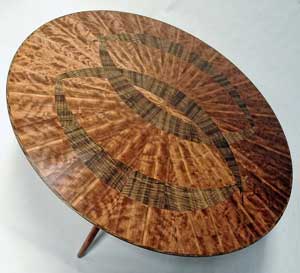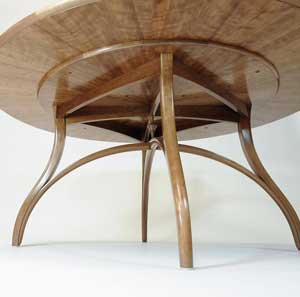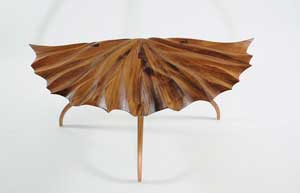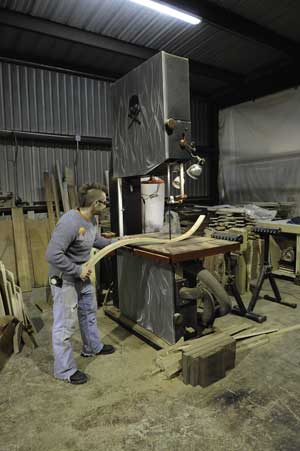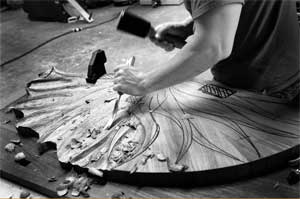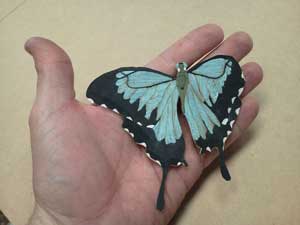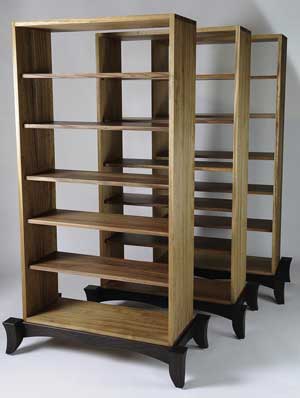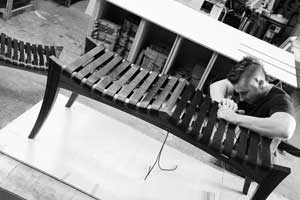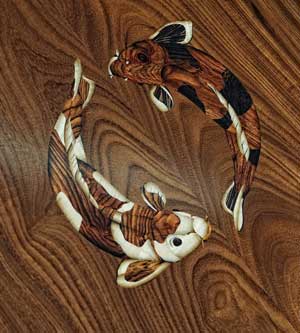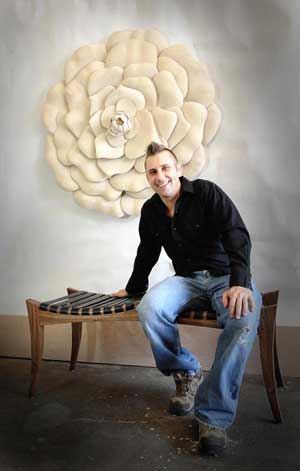
When Jeremy Grubb starts a woodworking project, “I’m normally just trying to push out a showstopper,” he said.
One example, from a recent project, is his wall-mounted camellia flower. Jeremy’s client, for whom he had already built other projects, including a dining table, saw the idea for a sculpture elsewhere but said to Jeremy, “I know you could do something better.”
The client did not see the 4-foot diameter flower sculpture until it was hung on his wall. Prior to that, Jeremy’s process was to transfer his drawing of the flower to the white mahogany wood he used, take a piece to the bandsaw, and cut it to shape. Then he would put a piece on the floor, block it off with plywood, stand on it, “and take an adze to it and start chopping off” (he did note that “I still have all my toes”). The substrate of the flower sculpture is “like a layer cake of Baltic birch, with every petal doweled into it, and set with hide glue,” he said. Of the 37 individual petals on the sculpture, each starts out 1/2″ thick, then sweeps up and contours into thicknesses ranging from 1/8″ to nothing. The center of the flower is turned, with the stamen finished with a clear coat of shellac — “so you can see how yellow the white mahogany is,” Jeremy said; the finish on the rest of the project is a whitewash made from shellac and wax.
“I’m trying to put stuff out there that really makes a statement,” Jeremy said. “With my clients, I push them to do cooler and cooler things.”
While he has taken “a handful” of woodworking classes, including one on hand-cutting dovetails, picked up information from magazines and books — and sometimes credits his childhood experiences at the University of Houston’s children’s art program as his “educational background” — mostly, Jeremy said, he learned about woodworking “just from making stuff.”
After leaving the U.S. Marine Corps, he worked as a bail bond runner and a bouncer while educating himself, gaining a master’s degree in sociology and a degree in interior design, and also running a remodeling business.
These days, he says, “I design ridiculously difficult stuff, and then I have to figure out how to make ’em.” With some of his pieces, it requires finishing off with hand tools because the design he’s created can’t be made another way. Other pieces require a different approach.
Currently, Jeremy is working on “really crazy organic shape sculptures out of veneer skins.” He’s using an “outside the bag” process, wherein he’s using vacuum bags, but his tapered and bent laminations are formed by being bent over the outside of the bag.
His other work with veneer has included building a chamber to fume his own veneer for a floating cabinet made of figured eucalyptus (the back panels were elm burl, and a diamond shaped inset made from book-matched eucalyptus). A current project is a bombe chest carcass made from molded plywood with “angel wings” doors and side panels: dyed wood veneers, which Jeremy says look like feathers.
“For one job, I might be laying a ton of veneer; another job might be very sculptural,” he said. “Everything I do, I try to push boundaries and do something different.”
While he does use a lot of African mahogany, Jeremy’s wood choices, he says, essentially come down to “the proper wood for the piece of furniture.” For finishes, he prefers to stick to a hand-rubbed oil finish, lacquer, or shellac and wax. “They’re all finishes that dissolve into themselves, and they’re also easier to repair in the future,” he said.
His joinery might be a combination, of loose tenons, hand-cut dovetails, or other choices: a bench with curved joints — Jeremy’s “lace corset” bench — is drawn together with double tenons.
He uses some old tools in his shop — he’s currently working on restoring an American Frank H. Clement Co. 36″ band saw from around 1900 and makes all his crosscuts on a 1950s Tannewitz table saw with a 16″ blade and a restored Rockwell slide. Newer shop favorites include a 12″ Laguna jointer and a 20″ Laguna planer with Shear Tec II cutting heads to minimize tear-out. Plus, Jeremy describes another band saw as a “36”, nine-foot-tall, monster.”
His approach to design, however, is fairly modern: “I try to keep a sense of harmony about the piece,” Jeremy said. “Modern styles are all about lines. They don’t have a lot of moldings to make them beautiful; you should be able to sketch a piece on the wall and step back, and it should be beautiful just from the lines alone.”
Overall, Jeremy said, “I just like to be crazy with it. I like making cool [stuff] out of wood.”
